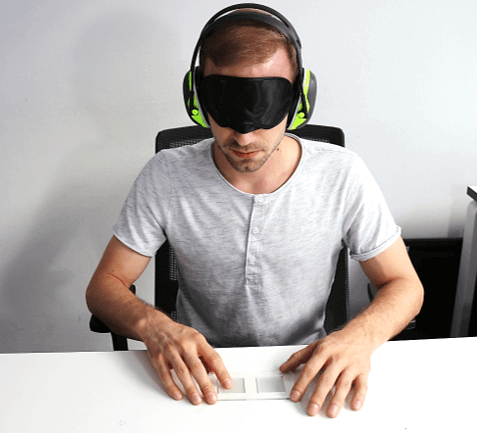Saarbrücken scientists research ergonomic, portable electronics

Scientists at Saarland University are working on operating mobile devices via the human body, as this is faster and more intuitive than using multi-touch displays. However, it has so far been unclear how different materials changed the perception of stimuli on the skin and thus also influenced wearing comfort. The researchers therefore investigated how flexible special films can be so that the skin perceives different stimuli. The computer scientists at Saarland University worked together with scientists from the Leibniz Institute for New Materials. Their results received an award at the renowned “Conference on Human Factors in Computing Systems”.
“Input devices worn on the skin enable a multitude of important applications,” explains Professor of Computer Science Jürgen Steimle from Saarland University. For example, sensors could monitor the state of health of any part of the body without being unpleasant for the person wearing them. Prostheses can also be improved in such a way that they feel like a real part of the body. Numerous prototypes have already proven their feasibility. Some of them, “Tactoo”, “SkinMarks” and “iSkin”, were developed by Steimle’s research group itself. “However, one crucial question had not yet been answered: How do the stick-on input and output films change the perception on the skin?” explains Jürgen Steimle. In order to clarify this question, the computer scientists at Saar-Uni cooperated with scientists from the INM – Leibniz Institute for New Materials in Saarbrücken and the Korea Advanced Institute of Science and Technology. Together, they developed multi-layer, stick-on silicon-based materials that adhere very well to the skin without adhesives and are reusable. “Adhesives can be unpleasant, in some cases even trigger an allergic reaction. That’s why we wanted to avoid using them,” explains Klaus Kruttwig, who heads the “Biointeractions” research group at the INM. In addition to so-called “tattoo paper”, which is a common solution for many previous systems, the scientists tested two different silicone patches the skin of 16 participants at an average age of 27 years. A comparable parameter was the different bending stiffness of the three materials. “Normally, thickness and elasticity are determined for similar measurements. However, we decided to use flexural strength here because it allows us to make comparable statements with a single parameter,” says Professor Roland Bennewitz, head of the Nanotribology program at INM.
The researchers carried out a total of three psychophysical experiments to determine the changes in touch sensitivity caused by the wearing of the materials. They found out that the most sensitive area, the fingertip, loses the most sensitivity through the application of the materials. However, no significant change in sensitivity could be measured in less sensitive areas of the skin, such as the forearm or palm of the hand. Using medium flexural strength promised the best balance between active perception and mechanical robustness. Based on their results, the scientists created a classification for interactive films worn on the skin according to their thickness and flexural strength. “Choosing the best material for such applications has been a difficult design issue so far because so little was known about tactile perception,” explains Aditya Shekhar Nittala, PhD student with Professor Steimle and first author of the publication. “Our work now helps designers find the best balance between material properties, mechanical robustness and tactile perception.”
The following people were involved in the project “Like a second skin”: Aditya Shekhar Nittala and Professor Jürgen Steimle from Saarland Informatics Campus at Saarland University, Jaeyeon Lee from Korea Advanced Institute of Science and Technology and Klaus Kruttwig, Professor Roland Bennewitz and Professor Eduard Arzt from Leibniz Institute for New Materials in Saarbrücken. They were awarded the “Honorable Mention Award” at the renowned “ACM CHI Conference on Human Factors in Computing Systems” in Glasgow. The research was funded by the Starting Grant “Interactive Skin” awarded by the European Research Council (ERC) and Grant 340929 of the Seventh EU Research Program.
Questions can be directed to:
Professor Eduard Arzt
Leibniz Institute for New Materials
Scientific Managing Director
Head of Functional Microstructures
eduard.arzt@leibniz-inm.de
Phone: +49 681-9300-500
Professor Jürgen Steimle
Chair of Human-Computer Interaction
Saarland Informatics Campus
Saarland University
E-Mail: steimle@cs.uni-saarland.de
Tel.: +49 681 302 71081
Editor:
Gordon Bolduan
Competence Center Computer Science
Saarland University
Saarland Informatics Campus E1.7
Phone: 0681/302-70741
Email: bolduan@mmci.uni-saarland.de
Die Öffentlichkeitsarbeit am Saarland Informatics Campus wird unterstützt durch das Kompetenzzentrum Informatik Saarland, gefördert aus Mitteln des Europäischen Fonds für regionale Entwicklung (EFRE) und Mitteln der Staatskanzlei Saarland.


